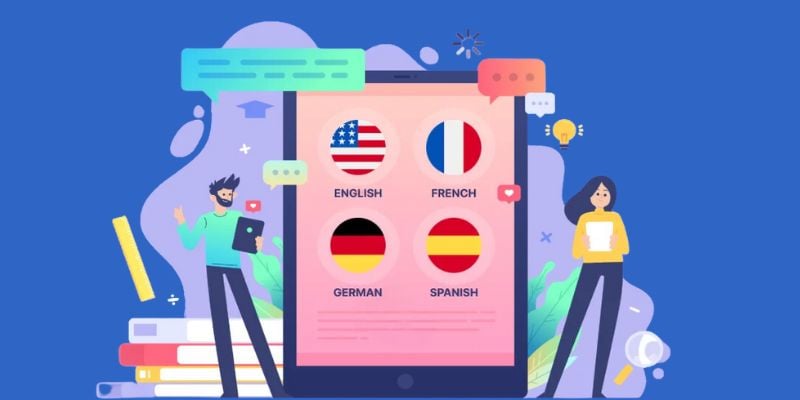Language learning apps function as an invaluable tool for people who wish to acquire new languages or raise their level of language competence. These applications serve as a dynamic space for users that tailors to different learning preferences and patterns, allowing people to participate in an individualised language learning process. Via collaborating interactive exercises, gamified learning, and multimedia content, these platforms entice the improvement of fundamental language abilities, such as grammar, vocabulary, pronunciation, and understanding. Moreover, tools like progress monitoring, customised feedback systems, and spaced repetition algorithms assist users in maximising their learning results. A global network of language learners is also accessible through a number of language learning apps, providing chances for peer cooperation and language exchange. All in all, language appscan strengthen people to amplify their speaking skills, widen their cultural horizons, and attain their ultimate objectives of learning engagingly.
Read About: Top Tax Calculator Apps
1. Duolingo
Duolingo is focused on engaging tasks that support the learning process by testing a person’s vocabulary. As such, a user is asked to speak phrases and words and translate or match them to their actual meaning. Duolingo is an America-based edtech firm that creates learning apps. Up until January 2024, 16.2 million individuals downloaded Duolingo per month, making it the most widely used language learning software globally. Most features of the app are free, featuring periodic ads in its browser extensions for computers and mobile devices, which users may turn off with a membership fee. Vocabulary is categorised by theme, and you advance following a set order, but if you are at a higher level, you can also attempt to skip some lessons. Super Duolingo is a premium version that holds benefits such as quizzes, level-skipping, and retries. Duolingo Max is a superior subscription to Super Duolingo. It can be found on the iOS Duolingo app in Canada, Australia, Ireland, the United Kingdom, New Zealand, and the United States for English speakers in French and Spanish.
Pros:
Progressive lessons are included.
Teaches structuring of sentences from scratch.
Features games such as learning streaks, engaging lessons, graphics, etc.
Covers all the learning skills.
Cons:
Doesn’t advance you past the beginner stage in most languages.
It has minimal or no practical usability for practising.
Doesn’t offer guidance on nuances and reasons in the usage of language and grammar.
2. Beelinguapp
Beelinguapp is the best language learning softwarefor polishing reading skills, unlike any other. Its goal is to help children enhance their language proficiency via stories, novels, fairy tales, news, etc. Every story is written in two languages: one is displayed at the top of the page and the other is shown at the bottom. You can read stories in two different languages simultaneously and listen to the stories with audio. The app lets users access text in 12 distinct languages, with extra languages being developed. Master a language regardless of your level of expertise, whether you are a novice, an immediate learner, or an expert. Consult stories in your language to understand the meaning of a word or phrase. Users can read at their own pace and choose to read by their choice.
Pros:
If there is a listed option, you can learn in your preferred language.
A wide range of stories, news and song lyrics are there.
Each story’s audio is accessible.
Cons:
Restricted number of free stories
Grammar explanations are improper
3. Memrise
Memrise, a language platform from Britain that is known as the best language learning softwarefor word association, utilises spaced repetition of flashcards to enhance learning speed. It usually offers user-generated content on broad subjects. It comprises courses in 16 different languages and possible combinations. However, the “community courses” website provides a broader range of languages to explore, including ancient and minority languages. As per 2018 statistics, 35 million users registered on the application. Its profits have been expanding since 2016, generating a turnover of $4 million per month. Users are allowed to improve their vocab by learning various types of phrases and words used by locals. They can even practise by listening to native speakers after they have learned some things. The AI language tutor is the best companion to aid a user in speaking in private with confidence.
Pros:
Premium quality of audio and video.
Learning can be customised and tailored to the goals.
Cons:
Words and phrases are taught separately without presenting in the context.
Grammar explanations are limited.
Limited opportunities to practise writing and speaking.
4. Busuu
Busuu is the best online language learning softwareon web, iOS, and Android allowing users to engage with local speakers. Busuu integrates the interactive elements of social learning into independent language learning. It offers free and premium access to 14 language courses through its mobile and web apps, which are available in 15 interface languages. Grammar teaching, oral and written discussions, spaced repetition vocabulary practice, and offline mode are exclusively offered to premium students. However, the free version provides a flashcard fix while assisting in deciding whether you are good to go with the complete subscription later. If a user is attracted to the format, they might purchase it, which allows them to take a view of conversations with speakers, exercises, certificates, questionnaires, etc. Utilise the study plan tool to arrange your learning and test your proficiency via the grammar review tool.
Pros:
Clarifications on vocabulary, grammar, and cultural aspects.
The choice to record responses and get feedback from locals.
Comprehension checks to grasp new words.
Cons:
Quality is dependent on the language course.
Content is not appropriate as per entertainment value.
Incorrect corrections can be received.
5. 0Languages
50Languages offers 100 lessons that give you a fundamental vocabulary. With prior experience, you will be able to converse fluently in simple phrases in various real-life scenarios. This is justified by the fact that the app is recognised as the best language learning softwarefor beginners. It commonly corresponds to the Levels A1 and A2 of the Common European Framework that are applicable to any student or school. The audio files serve as a supplement in schools and courses. Adults who are well-versed in a language can revise their knowledge using the app. 50Languages is accessible in more than 50 different languages and around 3000 language pairings, like German to English, Spanish to Chinese, English to Spanish, and more. Apart from being thebest app to learn other languages, it hosts a series of games, tests, and lessons that can be used to learn additional material vocabulary and reinforce past learnings.
Pros:
Top-notch content for beginners.
More than 50 languages are available.
Users can freely choose the language skills to learn about.
Cons:
The interface is not consumer-friendly.
Lessons are not described accurately.
6. Mondly
Mondly is an ed-tech firm that deals with the development of freemium language learning platforms, including a website and app, offering courses in 33 languages, both free and paid. It utilises a method that integrates vocabulary and phrase acquisition with speech recognition and chatbot advancements. Mondly has also launched a separate app named “Mondly Kids” that caters to kids and toddlers completely. The app is considered the best language learning software for finding innovative features. The software works effectively and adjusts to the users’ requirements. Recognised worldwide by platforms such as CNN, Business Insider, and Forbes, this language learning platform pioneers AR and VR experiences for language education. You can memorise core words, utilise them to frame phrases and sentences, and ultimately reconstruct the interaction in your voice. The app is made efficient for language learning with the aid of Speech Recognition and Spaced Repetition Algorithms.
Pros:
High-tech features draw users’ attention.
Leaderboards are an exciting activity and make learning easy.
Languages can be designated as either a target or native language.
Cons:
There is no differentiation between distinct levels.
Users need to take an annual membership to access different languages.
Advanced functionalities might seem to be unnatural.
7. Innovative Language
If you are seeking the best language learning softwarethat serves as an all-in-one space, Innovative Language Learning is the right fit. You can experience practical interactions by studying real lessons taught by actual mentors. Audio and video classes only last between 3 and 15 minutes. Click on the “Play” button to acquire practical conversations through short lessons in a podcast format. Users feel confident when they grab knowledge from actual experts and listen to live dialogues. After a certain time, users get assessed for their learning with professional quizzes. With the premium plus plan, you have the option to engage with your personal instructor as well. Being experienced for 16 years and user downloads of over 2 billion, you can learn with time-tested and verified software. You can access unpaid video/audio lessons weekly. If you want to try other services, subscribe to a free trial, and you can make freebies a part of your learning journey. The free trial of the language learning softwaregives complete access to extravagant courses, which consist of a library of video and audio lessons, notes, audio dialogues, word bank, etc.
Pros:
There are plenty of practical lessons.
You can learn on your terms.
The main emphasis is on the communicative method of learning languages.
Cons:
Lessons could have been more organised.
The quality of programs is inconsistent.
Highly engaging videos could improve lessons.
The dashboard could be enhanced with a more intentional design.
8. Drops
Drops, the best language learning softwareto polish vocabulary, was developed in Estonia by Daniel Farkas and Mark Szulyovszky in 2015. It aims to assist users in learning routinely just by dedicating five minutes daily. It works on the visual learning model, pairing images with words in the concerned language. In this manner, users can link to new words with their actual meaning instead of English words. The app provides an abundance of words for you to learn. Each language consists of approximately 1700 words that are divided into 99 topics. The best part of language learning softwareis that it can be used free of cost. Drops is an attractive app that educates learners on vocabulary with short daily sessions. However, its focus on keeping things short may be too much for some students, and the time constraints can be discouraging. If you find that your obsession with Drops is too intense to limit to just five minutes per day, you have the option to sign up for premium membership.
Pros:
The app hosts a minimalist interface.
Users can skip words learned already.
There are many topics to choose from.
Beneficial language-specific additions, such as practising Japanese kanji writing.
Cons:
Users have a free limit of five minutes.
Users cannot practise conversation.
It is only restricted to teaching vocabulary.
The paid version doesn’t comprise many features.
9. LingQ
LingQ is the app that helps you progress from beginner to fluent by surrounding you with accurate content and giving helpful tools to monitor your advancement. The users can import languages and learn them through any content available on the web. It is ideally used as the best language learning software for audio learners and as an audiobook player. It lets users listen and read along to grasp a new language. Create an account and sync your data to the web app to begin learning on both web and mobile platforms. The LingQ app allows you to learn without an internet connection and synchronises when you reconnect. You can save content to the flashcard deck and review them via the app’s SRS feature. The whole audio content is derived from the transcript so that you can save new words extracted from any content.
Pros:
The audio material is authentic.
You can get statistics and data about your learning progress.
You can upload your own content.
The interface is interactive and makes learning fun.
Cons:
Instructions are not given for grammar.
Writing and speaking abilities are neglected.
The import function is limited for use.
Some segments of the content contain errors.
Video content is absent.
10. Tandem
If you are looking for the best language learning softwarefor language exchange and obscure languages on iOS or Android, Tandem is the one. It connects you to native speakers directly. Members have the option to find language exchange partners to communicate with through text or voice chat. As per stats of October 2023, it supports over 300 languages, covering 20 indigenous and sign languages each, along with six fictional ones, like Mandalorian. In the discussion, equal time is allocated to both languages to support both partners in acquiring their desired language skills. The Tandem app is backed by Tandem Fundazioa, the firm responsible for creating the Tandem learning technique. When a user finds it challenging to search for suitable words, the in-app translation functionality helps in composing a text or translating the upcoming one. Improve your speaking skills by blending in with the locals using voice notes, audio, and video calls. The message correction and comment feature aids in quickly learning challenging segments. Embrace your unique language learning method, whether it be through texting, speaking on the phone, or meeting face-to-face.
Pros:
Private and group chat services include helpful integrated language tools.
Most of the program is freely accessible.
It provides measures to prevent misuse, such as background screening and a mechanism for reporting.
Cons:
It can be challenging to sift through a large volume of incoming messages.
Some people use it as a dating app.
Prioritises language practice over language acquisition.
It is pricier than similar apps in the market.
Also Read: Top Adult Apps
Benefits of using language learning apps
Innovative features
Using language learning softwarecan significantly enhance your experience while traveling abroad. These apps prompt travelers to use the local language by incorporating up-to-date expressions and phrases. Some people have a slang slider that displays levels, allowing users to customize their expressions. Many are divided into sections such as conversation, travel, and grammar. While learning new things can be tedious, some functionalities are useful and keep users engaged. Another key factor is the vast collection of narratives. These platforms come integrated with assistants that empower the skills while guiding all through the learning journey. The app should cater to various users, include tracking capabilities to ease progress management, and recommend suitable difficulty levels.
Peer-reviewed feedback
Regardless of these apps' claims, audiences desire to use the best language learning softwaretoday. A creative and appealing design indicates that the developers focus on gamifying the apps and working together to think deeply. Getting reviews from peers is advantageous as it lets users know how to implement the language. It also targets speaking skills because you will be able to gain knowledge from other individuals who are native speakers. Some users can submit their writing samples for feedback, and the native speakers can comment on those writing pieces and post a positive critique.
Accessibility
A UDL, short for an accessibility framework, consists of guidelines for creating online services that people with disabilities can use. Specifically, it holds the essence in the education sector because it is a guiding path for educators to estimate and gather the needs of learners suffering from different disabilities. However, not all language apps are available to disabled students. Language learning apps also have the important feature of being able to tailor their content to suit the individual learning styles of users. Some apps use an old technique, while others use modern methods to address learners. Certain apps allow you to view text on the screen, while others provide the ability to listen to the teacher’s explanations or real-life examples of the language in use.
Conclusion
Language learning platforms are pivotal in this interlinked world. It democratizes access to language education and offers customized and convenient learning experiences. These apps empower people to embark on a journey of linguistic proficiency by enhancing cultural understanding, fostering global communication, and opening doors to new opportunities. As we thrive in the digital space, the importance of Language learning app development should not be overstated. These apps entice language acquisition and encourage a more comprehensive understanding of diversity and a stronger bond with the world surrounding us. Using these apps means welcoming a bundle of opportunities introduced by language proficiency. It makes them essential in our pursuit of personal and professional advancement in a constantly evolving global landscape.










